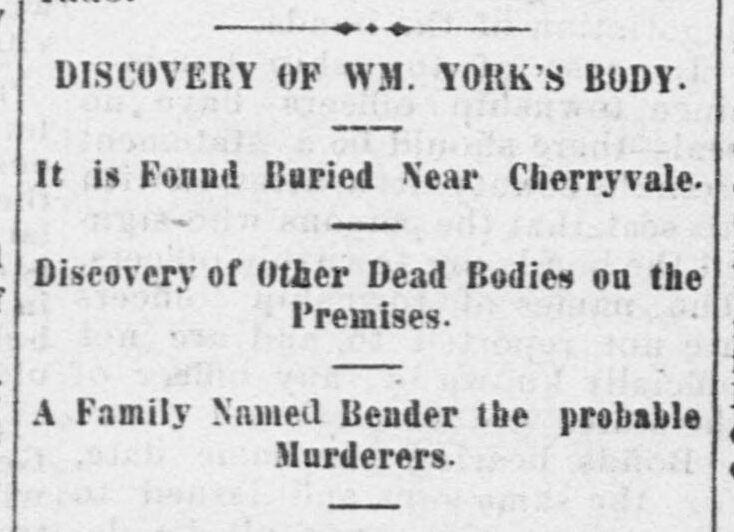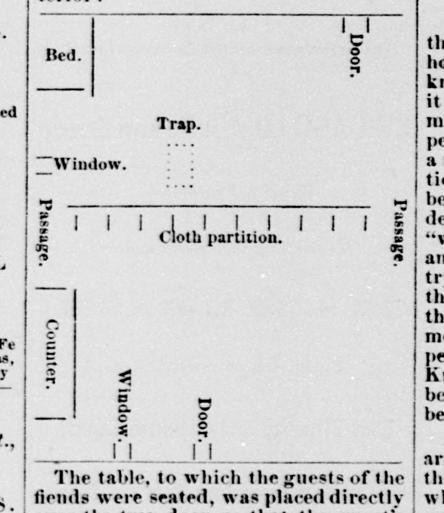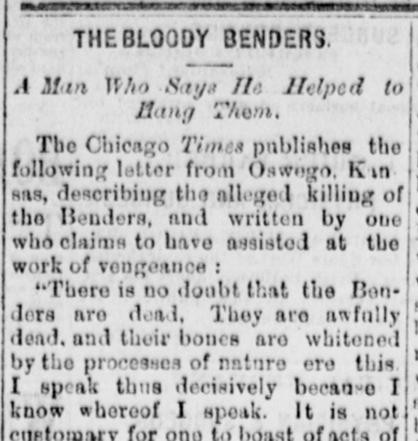In the vast, untamed prairies of 1870s Kansas, where homesteads were scarce and communities scattered, it was easy for secrets to bury themselves as deep as the newly turned soil. The Homestead Act of 1862 had lured settlers with the promise of 160 acres, but the isolation also created a breeding ground for darkness. Disappearances were not uncommon, attributed to the perils of frontier life. Yet, when a state senator’s brother vanished, the alarm bells finally rang, leading to the uncovering of a family whose name would become synonymous with terror: The Bender Family.
The chilling saga began in the spring of 1873 when Colonel Alexander M. York, a Kansas state senator, embarked on a desperate search for his brother, Dr. William York. William had disappeared along the desolate Osage Mission Trail while seeking his friend George Longcor, who himself had vanished months prior with his young daughter. The trail was unforgiving, offering little in the way of sustenance or refuge. Amidst this harsh landscape, the homestead of the Bender family offered a seemingly welcoming respite for weary travelers, a place for supplies and overnight lodging. But in early May, this isolated dwelling was found eerily deserted, setting in motion the unraveling of horrific crimes.
“Yesterday two men were looking at the claim so suddenly vacated by the Benders, and while they were in the garden, noticed a queer depression in the soil, and suspecting something wrong dug down.” – May 9, 1873, Emporia News.
On May 6, 1873, the grim discovery was made: William York’s body, crudely buried on the Bender property. This gruesome find exposed the terrifying truth and marked the beginning of the piecing together of the Bender family’s bloody deeds, revealing them as cold-blooded killers preying on unsuspecting travelers.

Newspaper clipping from 1873, Emporia News, detailing the discovery of William York’s grave on the Bender property, sparking the investigation into the Bender family murders.
Local authority Leroy Dick and detective Thomas Beers, hired by the determined Colonel York, meticulously documented their investigation for the newspapers. Their detailed reports, preserved in the archives and available for review, narrated the chilling process of uncovering the Bender family’s horrifying crimes and the desperate manhunt that ensued to capture the fleeing murderers, who had gained a significant head start of nearly a month.
“It has been impossible to get more than an outline of the terrible deeds, but we can assure our readers that all facts published in this paper are reliable. No person can describe the horribleness of the bloody deeds.”- May 23, 1873, Emporia News
By May 23, the Emporia News reported a shocking tally of up to eight graves unearthed on the Bender property, with a grim estimation of up to fourteen victims attributed to their murderous spree. The newspaper’s front page became a morbid roll call of the identified victims and detailed the frenzy surrounding the case, including the arrests of neighboring suspects and the macabre tourism as crowds flocked to the crime scene. Photographers captured the grim reality, and images of the Bender homestead and its horrors were famously published in Harper’s Weekly, bringing the terror of the Bender family to a national audience.
The Bender family itself was an enigma, described as consisting of an elderly German couple and two younger individuals, presumed to be their adult children.
An excerpt from the State Rights Democrat newspaper in 1873, detailing the description of the Bender family members, noting John Bender’s age, his daughter, Mrs. Bender, and her son.
Their method was as calculated as it was brutal. They offered hospitality to travelers, only to lure them into a deadly trap. Behind a curtain partition within their cabin, victims were ambushed with hammer blows to the head. Their bodies were then dropped through a trap door into the cellar below to bleed out after their throats were slit. Newspapers, attempting to capture the sheer horror of the Bender’s den, branded their property with ominous names like “Devil’s Kitchen” and “Hell’s Half Acre”, cementing their place in the annals of American crime. Diagrams of their cabin were circulated, illustrating the layout of this house of horrors.

A diagram of the Bender cabin as printed in the Wichita City Eagle in May 1873, illustrating the cabin’s layout with entryways, windows, the hidden trap door to the cellar, and the dividing curtain.
“Now that the curtain of mystery which has so long enshrouded the damnable deeds of the Bender family has been drawn aside, revealing to the public gaze the existence, in our very midst, of a system of cold blooded murdering almost unparalleled in the annals of crime, many little incidents are brought back to the memory of different ones, which are now known to have direct connection with the doings of that murderous crew…” May 22, 1873, Wichita City Eagle
A hefty reward of $5,000, a considerable sum in 1873, was offered by the state of Kansas for the capture of the Bender family. Despite an intense manhunt and several arrests based on promising leads, the fate of the Bender family remained shrouded in uncertainty, adding another layer to their already chilling legend.

A reward advertisement from the Wichita City Eagle, dated May 22, 1873, offering five thousand dollars for information leading to the capture of the Bender family murderers.
In August 1880, the Bender saga resurfaced in headlines as the Chicago Tribune reported the arrest of two individuals in Nebraska, suspected of being the elder Benders. These individuals purportedly confessed to the Kansas murders, and daily updates followed as they were transported back to Kansas for identification throughout the first week of August. However, by August 10, public skepticism grew, deeming them imposters, and they were released as reported on August 11.
Chicago Daily Tribune (Chicago, IL), August 11, 1880.
Amidst the trial of the supposed Benders, a Pennsylvania newspaper published testimony from S.A. James, claiming to have witnessed the Bender family’s execution in 1873. Two days later, the same paper expressed satisfaction that the discharged couple in Kansas were not the Benders, reinforcing the theory of their earlier, clandestine demise.
A collage of two newspaper articles from the Lancaster Daily Intelligencer. The left article, dated August 14, 1880, reports S.A. James’ sworn testimony of witnessing the Bender family’s execution. The right article, from August 16, 1880, concurs that the couple discharged in Kansas were not the Benders.
Adding to the mystery, a month later, another anonymous eyewitness account surfaced in a Pennsylvania paper, corroborating the claim of witnessing the Benders’ executions back in 1873.

Newspaper clipping from The Post, dated September 9, 1880, featuring an article titled “Bloody Benders,” detailing an anonymous man’s claim of assisting in their hanging.
In November 1889, the story took another turn when two women in Niles, Michigan, were identified as potentially being the Bender women. Frances McCann, daughter of victim George Longcor, played a crucial role in their apprehension. Leroy Dick was summoned for identification, and legal proceedings commenced in Kansas. However, by December, evidence emerged placing the women in Michigan during the 1873 murders, effectively debunking this lead.
Wichita Eagle (Wichita, KS), November 26, 1889.
Kate Bender, the younger woman of the family, became a figure of morbid fascination, her name perpetually linked to the sensationalism of the case. The press frequently addressed persistent rumors and local gossip, dispelling recurring claims of Kate Bender having secretly lived and died in various communities under assumed identities.

A collage of three newspaper articles from different years (1904, 1910, and 1920) debunking rumors of Kate Bender’s death in various locations, highlighting the enduring public fascination with her fate.
The Chronicling America* newspaper archives meticulously document the unfolding Bender narrative as it gripped the nation, revealing the enduring power of this gruesome and thrilling tale. While the line between fact and folklore blurs with time, the chilling headlines about the Bloody Benders continue to captivate, ensuring their dark legacy persists.
Explore More:
Kansas Historical Society: Kansas Memory
The Homestead Act: Research Guide
Historical Marker database – The Bender homestead
Nonfiction:
The Benders in Kansas by John T. James (1913)
The Benders: Keepers of the Devil’s Inn by Fern Morrow Wood (1992)
Fiction:
All the Blood We Share: a novel of the Bloody Benders of Kansas by Camilla Bruce (2022)
The Hell Benders by Ken Hodgson (1999)
*The Chronicling America historic newspapers online collection is a product of the National Digital Newspaper Program and jointly sponsored by the Library and the National Endowment for the Humanities.
Follow Chronicling America on X @ChronAmLOC
Click here to subscribe to Headlines & Heroes–it’s free!

